What is MIDI?
MIDI (Musical Instrument Digital Interface) was created in the 80s as a way for musical instruments to connect and talk to each other. The most common use of MIDI is with keyboards and digital pianos. A MIDI keyboard can connect to other devices to access different synths or samples.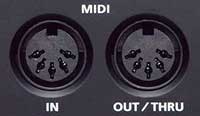
MIDI uses a 5-pin cable as shown to the right (read this guide to learn about different types of audio/data cables). Newer MIDI devices may use a USB port to connect to other MIDI devices so if a device doesn’t have the 5-pin ports, it may still be MIDI compatible.
MIDI can also be used to control different devices. Foot controllers often use MIDI to switch between different channels, banks and presets. A lot of touring guitarists use MIDI-based foot controllers to select different effects and presets during their performance. Even some delay pedals and looper pedals use MIDI as a way to sync up timing across different effects.
While there are quite a few different ways you can use MIDI as a guitarist, this guide will not look at MIDI foot controllers or how MIDI is used to sync different guitar pedals.
Find out all about MIDI Foot Controllers for Guitar in this guide.
In this guide, we’ll look at how you can convert your guitar’s signal into MIDI. Converting your guitar to MIDI allows you to experiment with different tones and sounds not usually possible on guitar. You can turn your guitar into a saxophone, piano, flute, drum kit or access a massive range of synths. If you’ve never tried this before, you might be surprised with what is possible.
If you’re looking for a way to experiment with your guitar and come up with some creative ideas, MIDI is a great option.
MIDI Guitar Pickups
The most common way to convert your guitar signal to MIDI is with a MIDI pickup. This is an external pickup you mount onto your guitar and is completely separate from your guitar’s normal pickups.
The way MIDI pickups work is they capture each individual string’s vibration and sends that information separately to a decoder. The decoder will then convert that information into MIDI.
Roland MIDI Pickups
Here is the Roland GK-3 – the most popular MIDI guitar pickup available today. The pickup mounts in between your bridge and your bridge pickup. It’s a divided pickup which means there are individual sensors under each string. The control unit also mounts onto the face of your guitar as shown below:
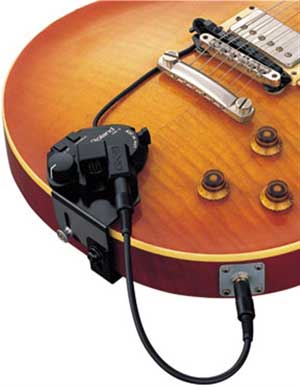
As you can see it’s not a subtle option. Unless you have a black guitar, the pickup and the wire will stand out. It is possible to modify the guitar to house the pickup internally. The GK-3 is the latest model and it’s already been out for over a decade. So for many guitarists, these pickups already look like relics. While they’re old, they’re still a very popular option and perform well.
It’s important to understand that the pickup by itself isn’t enough for you to get any sound. It needs to be paired with a processor such as the Roland GR-55 as shown below:
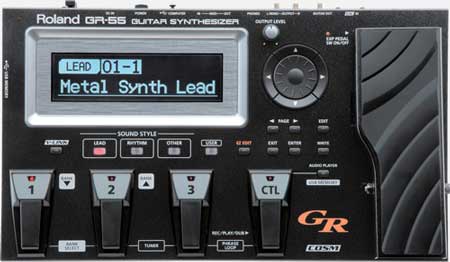
It looks like a typical guitar multieffects pedal, but it’s much more than that. These processors are the brains of the MIDI system. The MIDI pickup sends the string vibration information to the processor, which then converts each string into a pitch and uses the synth you set on the pedal. All the sounds you hear depends on the processor.
A cheaper alternative to the GR-55 is the BOSS GP-10:
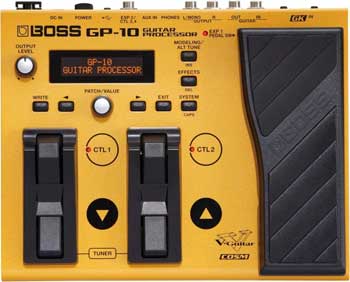
These processors allow you to set typical guitar tones as well as non-guitar sounds. They also let you change your guitar’s tuning on the fly because of MIDI’s flexibility.
Here’s a demo of the Roland GK-3 & the GR-55 in action:
Everything you hear in the above video is produced by the GR-55. None of the guitar tones come from the guitar’s pickups (you can see the guitar jack isn’t plugged in). This is important to note because it shows that you can still come up with regular guitar tones with a MIDI system – it’s not just for synth tones or emulating other instruments.
Because the MIDI pickup doesn’t use your existing pickups, you can actually plug your normal guitar output into the GP-10 to use as a typical multieffects unit. This means you can switch between your standard guitar tone and your MIDI tone as you want. You can even blend the two together. For example you can hear your normal guitar tone playing while having a lush pad in the background or double your guitar tone with a synth.
Fishman TriplePlay
An alternative to the Roland GK-3 is the Fishman TriplePlay Wireless MIDI Controller (link to price and full details on Amazon):
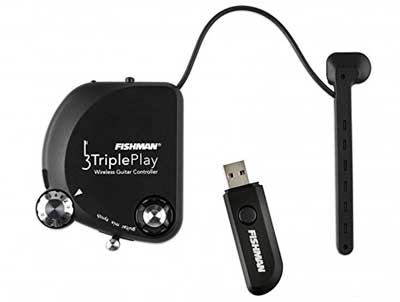
It looks almost the same to the GK-3, but with some important differences. It’s a wireless unit so you have no cable from your guitar to a pedal.
The TriplePlay doesn’t require a controller like the GK-3 does because it converts the signal to MIDI all in the one unit. The Roland system on the other hand requires the pickup and the controller to work. The TriplePlay does it all in one unit. As a result it’s a far cheaper system to set up and requires less equipment. All you need to do is plug the wireless receiver (USB) into a MIDI-compatible device to access sounds.
Here’s a demo and overview of the TriplePlay in action:
Here’s an excellent example of the TriplePlay connected to a PC and accessing a range of high quality synth sounds:
The TriplePlay’s wireless receiver uses a standard USB connector. While it’s designed to plug into a PC or Mac, you can use it with other MIDI devices with a USB to MIDI adapter.
Alternatively, you can connect the USB to an iOS device to access the large range of MIDI apps available. To connect the TriplePlay to an iOS device, you will need an Apple Lightning to USB Camera Adapter.
Simply plug the TriplePlay’s USB to the adapter and you can plug it into your iOS device and load up any MIDI based app such as SampleTank, EHX Mini-Synth or GarageBand. You can then access any synth or MIDI enabled app and use your guitar to control it.
Pros of using a MIDI pickup
- Good tracking
- Polyphonic
- Fits many electric guitar models
- Doesn’t use normal guitar pickups
- Can produce excellent guitar tones as well as other instrument/synth tones
- Excellent for live performances
Cons of using a MIDI pickup
- Ugly
- Bulky
- Does not fit all guitars
- Can be expensive
Who would a MIDI pickup suit?
This option suits guitarists who know that they want MIDI as a standard part of their sound. As the MIDI pickup is pretty much permanent, you want to make sure you really want MIDI before you mount one to your guitar.
The Fishman TriplePlay will cost around $400 while the Roland system will cost anywhere from around $500 to $1000 depending on what processor you buy. This option suits guitarists who want to have one rig and want that rig to be MIDI based.
If you’re not sure if this option is right for you, check out the alternatives below. There are cheaper options that may not produce the same quality results, but still give you a full MIDI system to experiment with.
Sonuus G2M
The next option is to connect a small device to your guitar’s output that will convert the audio signal to MIDI. As technology has improved, the quality of these devices has increased. As technology continues to improve, devices like these will eventually overtake the quality of the GK-3. At the moment the GK-3 provides far superior tracking quality, but eventually units like these will surpass that quality.
The Sonuus G2M is a monophonic guitar to MIDI converter. Monophonic means it can only handle one note at a time. It can track and convert single note riffs and lead lines, but as soon as you play more than one note at a time, it will fail. That means chords, double stops and arpeggios are out. For most guitarists this will be far too limiting, but for others it’s enough to try MIDI out, experiment and come up with some really interesting lead lines and effects.
The G2M shown above takes your regular guitar input and gives you a MIDI 5-pin output on the other side. The Chromatic switch allows you to turn bends/vibrato on or off. For example if you were trying to emulate a piano, vibrato would instantly ruin the piano feel so switching it off gives you better results.
Here’s the G2M V2 in action to show it’s tracking ability:
The first G2M had some very noticeable latency which was significantly improved on later models. While the unit was created for guitarists, it can also be used with other monophonic instruments as well such as bass guitar or voice.
An alternative to the G2M is the i2M which is designed to be used with a PC or Mac rather than connect to other MIDI devices.
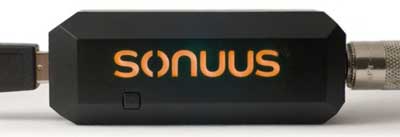
The advantage here is that you don’t need any MIDI equipment. You can plug the i2M to your PC/Mac and load up any MIDI software. It’s not permanent like mounting a MIDI pickup to your guitar so you can use it whenever you want and put it away when you’re done with it. While it is very limited due to being monophonic, it’s a handy tool to have.
Sonuus G2M Pros
- Low cost compared to a MIDI pickup system
- Small battery or externally powered unit
- Plug your guitar in without any modifications needed
Sonuus G2M Cons
- Monophonic
This is a low cost option and while it is limited to monophonic use, it’s a good way to start experimenting with MIDI. There are other methods below that are cheaper, but for some guitarists this might be the right option for songwriting or jamming purposes.
MIDI Guitars
This is a completely different option to all the other methods in this guide. With this option, you’re not trying to convert your guitar’s signal to MIDI. A MIDI Guitar is an instrument that produces MIDI so there’s no conversion needed.
The most well-known MIDI Guitar is the You Rock Guitar:
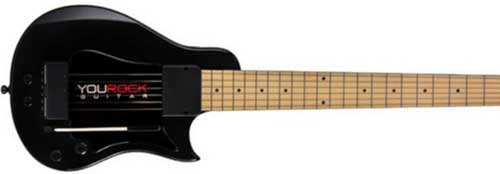
You can see that it looks similar to a guitar, but it’s clearly different. Like something straight out of the 80s, MIDI Guitars instantly stand out. The plastic build and the lack of strings make them really unusual instruments that are met with a lot of skepticism.
Try not to think of it as a guitar and instead think of it as a guitar-like instrument. It’s like playing a new instrument where you already know where all the notes are. In some ways it’s similar to playing a guitar while in other ways its nothing like guitar.
The below video is an excellent demonstration of how different a MIDI Guitar can be compared to a typical guitar with a MIDI converter:
You might notice that he isn’t picking the strings at all and can perform some interesting two hand tapping licks. You can switch between a standard mode where you need to pick the strings to sound a note and a tap mode where simply fretting the note produces a sound.
Bends and vibrato are performed using a tremolo bar because there are no strings. If you pick up a MIDI guitar, at first it’s going to feel jarring how different it is to play. Things you would naturally do on guitar like vibrato just don’t work on a MIDI guitar. For some guitarists this places a MIDI guitar in the ‘toy’ category.
But other guitarists recognize that a MIDI guitar requires a shift of mindset. While it’s a guitar-like instrument, you need to think of it as a different instrument. The best examples you will hear on a MIDI guitar are when the person doesn’t treat them like a guitar (like the above video).
The instrument can be connected to other MIDI gear or connected to any sequencer or software accepting MIDI input. Just like every other method listed here, you can access a massive range of sounds and tones by plugging the device to another MIDI device.
MIDI Guitar Pros
- Polyphonic
- Able to produce sounds and parts not possible with any other method
- Unique instrument forces you to think and play differently
MIDI Guitar Cons
- Does not feel or play like a guitar at all
- Need to adjust technique considerably to play properly
- Will not produce any realistic guitar tones
- Doesn’t use your own guitar like the other methods
It does appear that You Rock Guitar have gone out of business, so if you do find one to buy second-hand, be aware that the website is no longer there to provide you with support.
Who would a MIDI Guitar suit?
One look at the guitar above and you’ll know whether this option is right for you or not. If you’re looking for an extreme way to come up with different sounds and songs, this is an instrument worth looking into.
If you’re looking for something completely different that will instantly grab people’s attention, a MIDI Guitar may suit you.
Guitar to MIDI Apps & Plugins
Software has improved to the point where there are now programs and apps that can do a good job of converting your guitar signal to MIDI in real-time. As technology continues to improve, the apps available will become more accurate and flexible.
Having a Guitar to MIDI plugin is a handy tool to have when recording. With a plugin you’re able to record a guitar part and convert it to any other instrument using different synths and sample based instruments. If you don’t like the idea of using a MIDI keyboard to record other instruments for your songs, using a converter plugin would be a useful option.
Jam Origin’s MIDI Guitar 2 is a fully featured plugin suite you can load into popular DAWs.
In the above video all the sounds you hear are produced by the MIDI Guitar 2 software. But you can easily expand the range of instruments and sounds by sending the MIDI signal to any other instrument in your DAW.
I tried out the iOS version while reviewing the EHX Mini-Synth app. I plugged my guitar into the iPad Mini using an iRig HD 2, loaded the MIDI Guitar 2 app, then routed the MIDI internally to the Mini-Synth app. It was quick and easy to do and the results were very impressive (my iPad 2 didn’t work very well though).
You’re able to switch between polyphonic and monophonic modes and both produced great results. Older iOS devices will experience issues as the app is very CPU hungry. My iPad 2 struggled to keep up and notes would cut in and out as a result. On newer devices or on a PC or Mac this wouldn’t be an issue.
The key to remember here is that this option requires you to have a PC/Mac or iOS device. You’re tethered to a computer or tablet so it’s not ideal for live performance. But if you’re looking for an option to play around with MIDI at home, it’s a great choice.
MIDI App Pros
- Very low cost option
- Free trials available
- Polyphonic
- Doesn’t require any extra hardware
- Access high quality sample libraries and virtual instruments
- Compatible with DAWs
MIDI App Cons
- Tracking quality can vary depending on app
- Not suitable for most live purposes
If you’re curious about MIDI and want to give it a go before you buy any gear or software, I recommend trying out the free trial for the MIDI Guitar 2 software. It will give you a good idea what MIDI is capable of and then you can decide which direction to go.
How to Get Started with MIDI
After you choose a method, set up your MIDI rig and play around with it for a while, you’ll probably wonder what to do next. Here are some ideas to get you started with MIDI and get a feeling for what directions you can go:
Learn about different instruments
Play around with a piano setting and you’ll quickly notice that although the notes sound like a piano, what you play sounds nothing like piano. This is because you’re still in a guitarist mindset. Strumming chords or playing typical guitar licks isn’t what a pianist would play and will sound terrible if you try it.
This gives you a great opportunity to learn about other instruments and develop your musical understanding.
Watch some videos of people playing piano and see how they arpeggiate chords and add in simple melodies. Try to get a feeling for what chord voicings pianists play and find those voicings on guitar.
If you’re playing with a saxophone sampler, listen to songs that have saxophone parts and get a feeling for what you’re hearing. Listen to how the saxophone moves between notes and try to copy that on your guitar.
Every instrument you can access on your MIDI system gives you an opportunity to learn more about other instruments. If you want to play convincing parts, you need to learn how those instruments work. It will take a while, but you’ll become a far better musician as a result.
Cover songs on other instruments
The best way to learn about other instruments is to learn how to play songs or parts meant for other instruments. Learn to play the sax solo from ‘Never Tear Us Apart’ by INXS, give the flute backing to ‘Stairway to Heaven’ a go or rock out with the organ parts in ‘The House of the Rising Sun’ by The Animals.
Look through music you normally listen to and pay attention to other instruments. Learning how to play those parts on your MIDI system will really help you grow as a musician. It’s also a lot of fun.
Understand the limitations of your system
If you buy gear or software that only works in monophonic, learn to adjust your playing style to get a nice clean monophonic sound. You might need to switch to different pickups or adjust your tone control to get the best tracking.
If you notice any tracking issues or latency, try to adjust your settings to avoid it as much as possible and learn what type of playing causes issues. Maybe you’re picking too softly or string noise is confusing the system. Learn what causes issues and adjust your playing style to suit.
Experiment
Branch off from the standard synth tones you hear guitarists use and try everything out. Try to play a drum beat on guitar using a drum sampler. Try to layer a lot of instruments on top of each other to come up with some lush atmospheric effects. Connect a looper pedal to the mix and lay down some backing tracks to jam over.
MIDI can give you a lot of creative freedom so take advantage of it. There are things you can do with MIDI that just aren’t possible on a normal guitar. So experiment and come up with new ideas and sounds.
